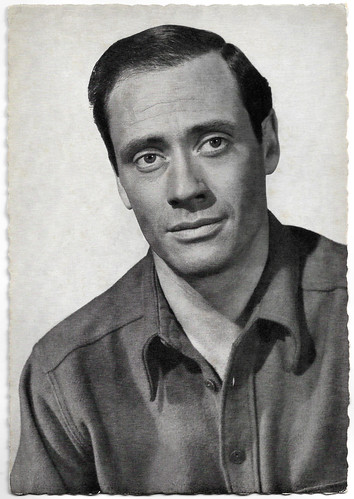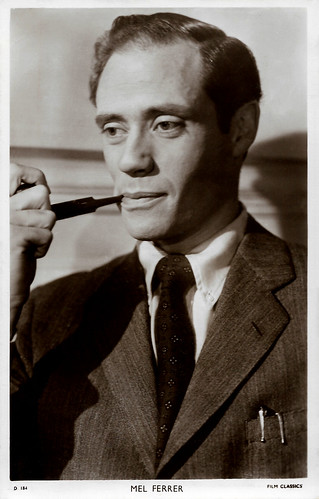
Vintage postcard, no. 952. Photo: R.K.O. Mel Ferrer in Rancho Notorious (Fritz Lang, 1952).

British postcard in the Picturegoer Series, London, no. D. 364. Photo: Metro-Goldwyn-Mayer. Mel Ferrer in Lili (Charles Walters, 1953).

Dutch postcard by Takken, Utrecht, no. 1598. Audrey Hepburn and Mel Ferrer.
Assistant to John Ford
Melchor Gaston 'Mel' Ferrer was born in Elberon, New Jersey, in 1917. His father, who died in 1920, was a Cuban-born surgeon and chief of staff at St Vincent's Hospital in New York. His mother was Mary Matilda Irene O'Donohue, the daughter of Joseph J. O'Donohue, a coffee merchant who had become a commissioner in the New York City Department of Parks and Recreation. Ferrer had two sisters and a brother.
Mel attended Bovée School in New York and Canterbury Prep School in Connecticut. Het studied briefly at Princeton University and made his stage debut in the play 'Awhile to Work', for which he won the Theatre Intime award for best new play by a Princeton student. His partner was Frances Pilchard, whom he married in 1937. At 21, he performed as a chorus dancer on Broadway in 1938 in two musicals.
Two years later, he made his Broadway debut as an actor. After contracting polio, he first worked as a disc jockey in Texas and Arkansas and then moved to Mexico to devote himself to writing the novel 'Tito's Hat', published in 1940. He eventually returned to Broadway and entered the film business. He also directed and produced several radio programmes for NBC.
He made his modest directorial debut with the drama The Girl of the Limberlost (Mel Ferrer, 1945). He returned to acting on Broadway to star in Lillian Smith's 'Strange Fruit' and then assisted John Ford on the set of The Fugitive (John Ford, 1947) starring Henry Fonda and Dolores del Rio, in which he also made a small appearance.
Along with Gregory Peck, Dorothy McGuire and Joseph Cotten, he founded the La Jolla Playhouse in San Diego. He directed Claudette Colbert in The Secret Fury (Mel Ferrer, 1950) and got his first real role in the drama Lost Boundaries (Alfred L. Werker, 1949) with Beatrice Pearson, where he played a light-skinned doctor from New Zealand, who passed for white while living in New England in the 1930s and 1940s. The film won the 1949 Cannes Film Festival award for Best Screenplay.

French postcard by Edition du Globe, Paris, no. 447. Photo: Sam Lévin.

West German postcard by Ufa/Film-Foto, Berlin-Tempelhof, no. FK 4383. Photo: Sam Lévin / Ufa.

West German postcard by WS-Druck, Wanne-Eickel, no. 254. Photo: MGM / Archiv Filmpress Zürich.
'Hi-Lili-Hi-Lo'
After being noticed, Mel Ferrer went on to play more important roles, notably in Born to Be Bad (Nicholas Ray, 1950). The following year, he played Marlene Dietrich's lover in the Western Rancho Notorious (Fritz Lang, 1951).
Then he played the Marquis of Maynes in the classic Swashbuckler Scaramouche (George Sidney, 1952) opposite Stewart Granger and Janet Leigh. The film, particularly notable for a long, climactic sword fight between Ferrer and Granger, was a huge hit. In 1953, he played opposite Leslie Caron in the musical Lili (Charles Walters, 1953). It was another big success. Ferrer and Caron also got a hit single out of it, 'Hi-Lili-Hi-Lo'.
That same year, he met Audrey Hepburn and immediately thought of her for a play by Jean Giraudoux, 'Ondine' (1954), on Broadway. The two fell in love and married in 1954 in Switzerland. Mel Ferrer made a name for himself on screen in the British historical adventure film The Knights of the Round Table (Richard Thorpe, 1953), where he played King Arthur, who competed with Robert Taylor for the love of Ava Gardner.
He played a dashing captain in the British musical comedy Oh Rosalinda (Michael Powell, Emeric Pressburger, 1955). With Audrey Hepburn and Henry Fonda, he starred in the blockbuster War and Peace (King Vidor, 1956), based on Leo Tolstoy's 1869 novel of the same name. With a huge budget, thousands of extras and historical reconstructions, it was a long, tough shoot, but the film was a success. Mel Ferrer played a very dignified Prince Andrei.
The following year, he was one of Ingrid Bergman's suitors in Elena et les Hommes/Elena and Her Men (Jean Renoir, 1956), then a tormented writer in The Sun Also Rises (Henry King, 1957), an all-star adaptation of the 1926 Ernest Hemingway novel of the same name. He returned to directing with Green Mansions (Mel Ferrer, 1959), starring Audrey Hepburn, in which he had a part of the Amazon rainforest reconstructed in the studio.

Dutch postcard by Takken, Utrecht, no. AX 1912. Photo: Ufa. Audrey Hepburn and Mel Ferrer. Collection: Marlene Pilaete.

British postcard in the Picturegoer Series, London, no. D. 184. Photo: Film Classics.

German postcard by Kunst und Film Verlag H. Lukow, Hannover, no. L2/1042. Caption: Filmschauspieler aus aller Welt (Film actors from around the world). From top left to down right: Linda Darnell, Tyrone Power, Elizabeth Taylor, Robert Taylor and his wife Ursula Thiess, Gina Lollobrigida and her husband Milko Skofic, Audrey Hepburn and Mel Ferrer, Mona Baptiste, Mara Lane and Gloria DeHaven.
A complex and tormented man
In 1961, Mel Ferrer took part in the war film The Longest Day (Bernhard Wicki, Andrew Morton, Ken Annakin, 1962) alongside an all-star cast including John Wayne, Henry Fonda and Robert Mitchum. Another major production, albeit a failure, was Anthony Mann's The Fall of the Roman Empire (1963). He then embarked on a more international career, shooting extensively in Europe, notably in France for Julien Duvivier and in Italy for Luciano Salce.
In an atypical role, Mel Ferrer played French priest and educational reformer Jean-Baptiste de La Salle in the Spanish biopic El señor de La Salle/Who Are My Own (Luis César Amadori, 1964). In Spain, he also directed his last film, a musical with teen star Marisol, Cabriola (Mel Ferrer, 1965). In 1967, he produced the psychological thriller Wait Until Dark (Terence Young, 1967), his last collaboration with Audrey Hepburn, whom he encouraged to accept the role. They separated the following year. A complex and tormented man, he never really accepted the fact that his wife was more famous than he was.
During the 1970s, he appeared in several Italian cult films, including the supernatural horror film L'anticristo/The Antichrist (Alberto De Martino, 1974), the Giallo Morte sospetta di una minorenne/The Suspicious Death of a Minor (Sergio Martino, 1975), the Swashbuckler Il corsaro nero/The Black Corsair (Sergio Sollima, 1976) starring Kabir Bedi, and the Science-Fiction Horror film Incubo sulla città contaminata/Nightmare City (Umberto Lenzi, 1980).
He went to Germany for two interesting films. Wolfgang Staudte's last feature film, Zwischengleis/Yesterday's Tomorrow (1978) with Pola Kinski, and Rainer Werner Fassbinder's Lili Marleen (1981) starring Hanna Schygulla. From 1981 to 1984, he also rose to prominence among television viewers through his part in the TV series Falcon Crest in which he played the role of Philip Erickson, the rogue lawyer of leading lady Angela (Jane Wyman), whom he eventually married briefly. He also appeared in the TV Mini-Series Peter the Great (Marvin J. Chomsky, Lawrence Schiller, 1986) starring Maximilian Schell. His final film was the action film Eye of the Widow (Andrew V. MacLaglen, 1991).
Ferrer directed more than 10 films and acted in more than eighty. For his part in the film industry, Mel Ferrer received a star on the Hollywood Walk of Fame at 6268 Hollywood Blvd. Ferrer married five times. His first and third marriages were to the same woman, Frances Gulby Pilchard, the first from 1937 to 1939, the second in 1944, both marriages ended in divorce. His second marriage (1940) was to Barbara C. Tripp, this marriage also ended in divorce. His fourth marriage was to Audrey Hepburn, from 1954 to 1968. His fifth marriage, in 1971, was to Elizabeth Soukhoutine. He had six children, including Sean Hepburn Ferrer with Audrey Hepburn. Mel Ferrer died of heart failure at a convalescent home in Santa Barbara, California, in 2008, aged 90.

German postcard by Kunst und Bild, Berlin-Charlottenburg, no. S 760. Photo: Metro Goldwyn Mayer. Mel Ferrer in The Vintage (Jeffrey Hayden, 1957).

German postcard by Kunst und Bild, Berlin-Charlottenburg, no. C D 22. Photo: M.G.M. Pier Angeli and Mel Ferrer in The Vintage (Jeffrey Hayden, 1957).

West German postcard by Ufa/Film-Foto, Berlin-Tempelhof, no. FK 3819. Photo: Centfox (20th Century Fox). Mel Ferrer in Fräulein (Henry Koster, 1958).
Sources: Wikipedia (Dutch, French and English) and IMDb.
No comments:
Post a Comment